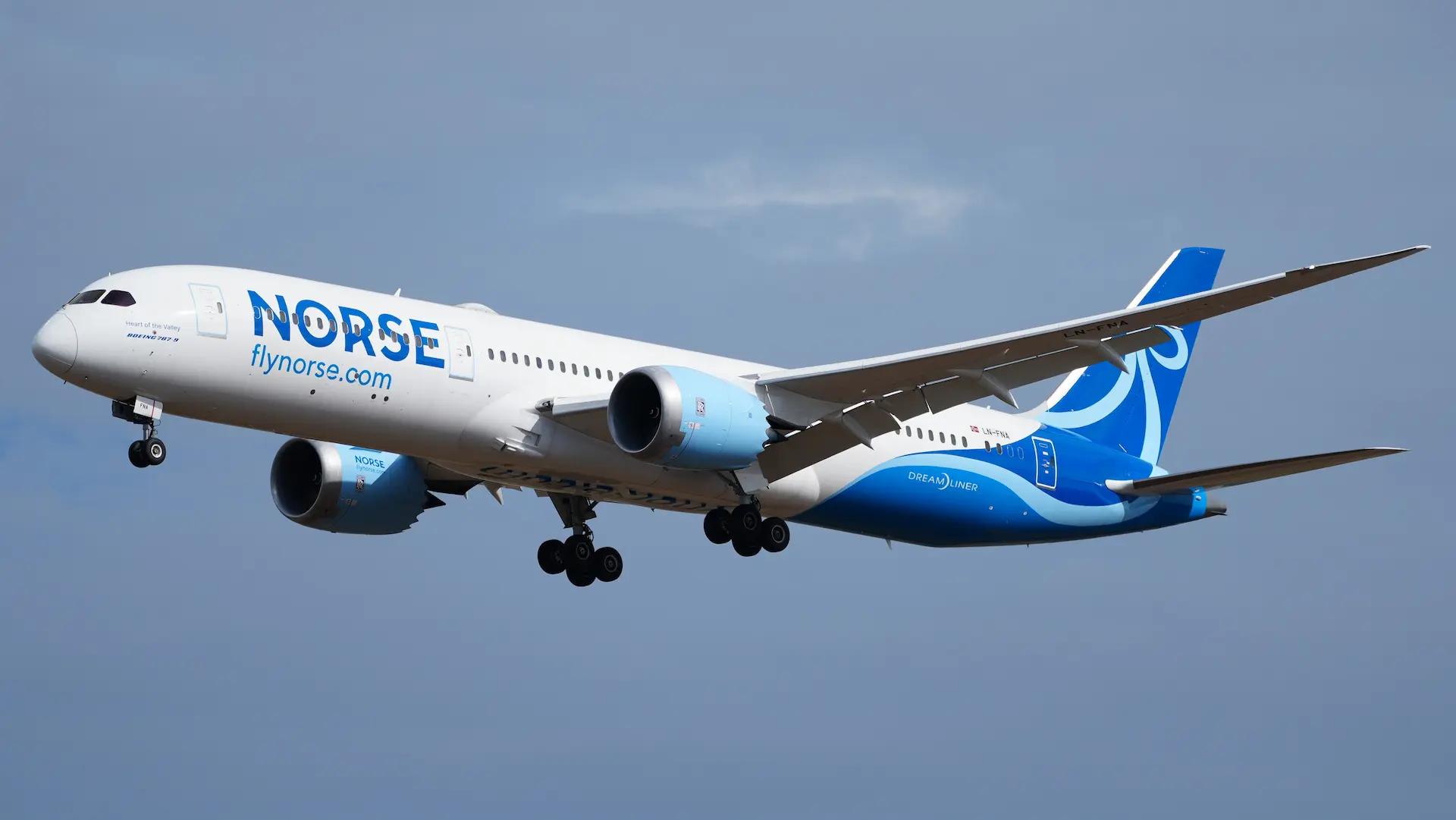Norse Atlantic Airways entered the transatlantic market with a promise: affordable long-haul travel between Europe and North America without sacrificing safety or modernity. It’s a bold proposition, especially in a market dominated by full-service giants like British Airways, Lufthansa, and Delta.
I’ve flown Norse on multiple occasions over the last 18 months, between New York, London, Oslo, and Fort Lauderdale. This review covers what Norse gets right, where it cuts corners, and what you should expect in terms of seats, pricing, reliability, and overall value.
What Kind of Airline Is Norse?
Norse Atlantic is a low-cost, long-haul airline based in Norway, launched in 2021. It operates exclusively Boeing 787 Dreamliners across its transatlantic routes, offering both economy and premium cabins.
The airline’s business model resembles Norwegian Air’s long-haul operations before it exited the market. But Norse aims to improve on Norwegian’s past mistakes by streamlining operations and focusing on fewer, high-demand routes.
As of mid-2025, Norse connects cities like New York (JFK), Los Angeles, Miami, London Gatwick, Berlin, Oslo, Rome, and Paris, with expansion to Asia under review.
What’s the Cabin Experience Like?
Economy Class
In Economy, the seats are standard 3-3-3 configuration with 31 inches of pitch and limited recline. The legroom feels similar to what you’d find on a legacy carrier’s short-haul route. The seats are basic, firm, and offer no frills.
Entertainment screens are available, but content is limited compared to airlines like Delta or Lufthansa. You’ll need to bring your own headphones or buy a pair onboard. There are USB ports, but no full power outlets.
Premium Cabin
Norse also offers Premium seats, not a true Business Class, but closer to what premium economy looks like on major carriers. Seats are in a 2-3-2 layout, with 43 inches of pitch and increased recline. The cabin is noticeably quieter and more private.
While you still won’t get flat beds or lounge access, the extra space, priority boarding, and checked bag allowance make it a good value for long-haul travelers who want comfort without a high price tag.
What’s the In-Flight Service Like?
Norse operates with a low-cost carrier service model, which means nearly everything beyond the seat itself comes at an extra cost, unless you’re in Premium.
In economy, meals must be pre-ordered or bought onboard. Blankets, pillows, and headphones are available for purchase. Water is free, but hot meals and soft drinks cost extra.
Crew professionalism, in my experience, is better than expected. Staff were polite, attentive, and fluent in English. On a recent flight from JFK to London, the crew proactively offered water during turbulence and handled delays with transparency.
If you go in expecting a no-frills product, you’ll find the service surprisingly smooth and respectful.
I recommend either bringing your own food or pre-ordering if you expect to need a full meal onboard.
Is Norse Airlines Safe?
Yes, Norse Atlantic operates under strict European Union Aviation Safety Agency (EASA) and FAA safety standards, as it operates between the EU, UK, and the U.S.
Their fleet of Boeing 787-9s is relatively new, with an average age under 10 years. The Dreamliner is known for its advanced safety features, fuel efficiency, and lower cabin altitude, which improves passenger comfort.
As of June 2025, there have been no reported safety incidents or regulatory actions against Norse. Maintenance is performed in compliance with international aviation regulations, and the airline has passed all operational certifications required to fly transatlantic routes.
From a safety standpoint, Norse ranks equally with major carriers and does not cut corners.
How Punctual Is Norse in 2025?
Norse has improved its punctuality since 2023. According to Cirium and OAG reports, its on-time performance in early 2025 hovers around 78%, which is acceptable for transatlantic operations.
Most delays are tied to airport congestion at JFK or Gatwick, not mechanical faults. I experienced two minor delays, one 35-minute departure delay in Berlin due to late arrival, and one 50-minute arrival delay into Fort Lauderdale due to weather.
Norse operates fewer frequencies than full-service carriers, meaning a missed connection might require rebooking for the next day. This is important if you’re connecting onward from a Norse flight.
What Are the Real Costs of Flying Norse?
Base fares on Norse are among the lowest in the industry. I’ve seen JFK to London Gatwick round-trips as low as $340, which is significantly cheaper than legacy carriers. But travelers must account for add-ons, including:
- Seat selection
- Meals
- Checked baggage
- Priority boarding
- Headphones or amenities
These can easily add $100–$180 per round-trip, depending on your selections. Still, even with upgrades, Norse usually undercuts major competitors by 15–30% on price.
The Premium cabin often sells for $700–$900 round-trip on JFK–OSL or JFK–LGW routes, offering good value compared to business class tickets priced over $2,500.
How Is the Booking and Customer Service Experience?
Booking is straightforward on the Norse website, but the upsell path is aggressive. You’ll be prompted to add bags, meals, and seat selection at every step. Prices fluctuate, so locking in early is often cheaper.
Customer service is functional but not proactive. In my experience, email response times vary from 24 hours to 3 days. There is no call center in many markets, which can be a problem during disruptions. Airport agents are often contracted, not Norse employees, so problem resolution can be slow.
Travelers should treat Norse as self-service first. Download boarding passes early, know your fare conditions, and avoid relying on staff for complex issues.
Where Does Norse Fly in 2025?
As of mid-2025, Norse operates a growing number of long-haul routes focused primarily on transatlantic demand.
Active Routes Include:
- New York (JFK) – London Gatwick
- New York (JFK) – Oslo
- Los Angeles – Berlin
- Miami – Paris
- Orlando – Rome
- Fort Lauderdale – London
Seasonal services to Bangkok and Cape Town are under discussion, according to Norse investor releases, though not yet confirmed.
Route reliability depends on seasonality and demand. Norse has cut underperforming routes quickly, which helps maintain punctuality but can lead to sudden schedule changes.
Who Should Fly Norse , and Who Shouldn’t?
Norse is a great option for price-sensitive travelers looking to cross the Atlantic or reach Southeast Asia on a budget. It’s especially ideal for digital nomads, students, and flexible travelers who value aircraft quality but can forgo full-service luxury.
However, if you’re on a tight schedule, have complex connections, or need frequent elite-level support, Norse may not be the right choice. The lack of global alliances, limited rebooking help, and no lounge network limit its appeal to premium travelers.
Is Norse Airlines Worth It in 2025?
Yes, if you know what you’re getting into. Norse delivers clean, modern aircraft and very low base fares, especially for transatlantic routes. The Premium cabin offers solid comfort at a fraction of Business Class pricing elsewhere. However, the bare-bones nature of its service model means you’ll need to manage expectations and prepare ahead.
Personally, I’ll continue to use Norse when the route and price make sense. It’s not luxurious, but it’s safe, affordable, and efficient, three things I value when choosing low-cost, long-haul carriers.
FAQs About Norse Airlines
Is Norse Airlines a budget airline?
Yes. Norse follows a low-cost, long-haul model similar to what Norwegian Long Haul once offered.
Are meals included on Norse Airlines?
Only in Premium class. In Economy, meals are optional and must be purchased.
Is Norse safe to fly?
Yes. Norse operates under full EASA and FAA safety oversight with a modern Boeing 787 fleet.
Does Norse Airlines have lie-flat seats?
No. Norse does not offer business class or lie-flat seating. Premium seats are recliner-style only.
Is Norse reliable?
Moderately. On-time performance in 2025 is around 78%, with most delays tied to airport conditions rather than airline issues.





